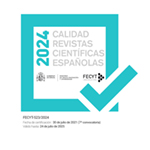Diseño arquitectónico, patrones de ocupación y formas de poder en Pachacamac, Costa central del Perú
Resumen
Una de las mayores dificuldades para el arqueólogo es diferenciar, sobre la base de los vestigios materiales, las autoridades «religiosas» y «seculares» en las sociedades tradicionales. Sin embargo, en el caso de Pachacamac, el examen de los datos disponibles revela una separación de poderes durante el Periodo Intermedio Tardío (ca s. X-XV d.n.e.). Al parecer, los templos se caracterizan por su ubicación, diseño arquitectónico, sistema de tránsito, patrón de ocupación y de decoración específicos. Estos elementos están ausentes o son totalmente diferentes en lo que concierne a una serie de edificios del sitio: las pirámides con rampa, interpretadas como palacios de señores localDescargas
Descarga artículo
Licencia
La Revista Española de Antropología Americana, para fomentar el intercambio global del conocimiento, facilita el acceso sin restricciones a sus contenidos desde el momento de su publicación en la presente edición electrónica, y por eso es una revista de acceso abierto. Los originales publicados en esta revista son propiedad de la Universidad Complutense de Madrid y es obligatorio citar su procedencia en cualquier reproducción total o parcial. Todos los contenidos se distribuyen bajo una licencia de uso y distribución Creative Commons Reconocimiento 4.0 (CC BY 4.0). Esta circunstancia ha de hacerse constar expresamente de esta forma cuando sea necesario. Puede consultar la versión informativa y el texto legal de la licencia.









